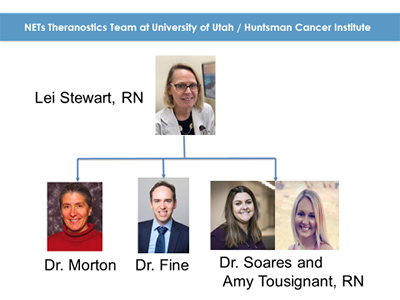NET Care Partnerships and Theranostics at the University of Utah
The incidence and prevalence of neuroendocrine tumors (NETS) are steadily increasing in the United States. NETs are a heterogeneous group of diseases including GI, pancreas, lung NETs as well as paraglangliomas and pheochromocytoma. Heloisa Soares, medical oncologist, joined the Division of Oncology in December 2019 as an assistant professor to focus most of her clinical and research efforts in NETs. As part of her role at HCI, she is further facilitating the multidisciplinary care that these patients need and deserve.
One the new advances in the NET field is in regards to Theranostics. Theranostics is the concept of integrating diagnostic and therapeutic tools to treat patients. An early example of this is I-131, which is used both as to diagnosis and treat thyroid disorders. For neuroendocrine tumors, that means the use of somatostatin-receptor imaging (e.g. Ga-68 or Cu-64 DOTATATE PET-CTs), as most of NETs express somatostatin-receptors in the surface of their cells, to identify tumors that can be treated with Peptide Receptor Radionuclide Therapy (PRRT). PRRT is as molecular targeted therapy which uses a small peptide (a somatostatin analog similar to octreotide) coupled with radioisotope to target tumors. PRRT has been available at the University of Utah since May 2018 and, subsequently, 63 patients have been treated.
subsequently, 63 patients have been treated.
In order for patients to receive treatment, they are referred and reviewed by the Theranostics team (see figure to the right). Dr. Kathryn Morton (Chief of Nuclear Medicine, Department of Radiology), Dr. Gabriel Fine (Department of Radiology), Lei Stewart (lead nurse for PRRT) and Dr. Heloisa Soares, meet on weekly basis to discuss our NET patients and indication for PRRT. Dr. Karen Brown (Chief of Interventional Radiology, Department of Radiology), often attends the meetings to weight in as liver directed therapy plays also a key role in the management of neuroendocrine tumors. Dr. John Morris (Division of Gastroenterology, Department of Internal Medicine) also provides support and input to our patients along with our colleagues from Surgical Oncology under the leadership of Dr. Courtney Scaife.
Patients with paraglangliomas and pheochromocytoma also have a dedicated group of providers caring for them. Once a month, several health care providers at HCI, including Dr. Luke Buchmann (Department of Surgery), Samantha Greenberg, MPH, Dr. Heloisa Soares, Dr. Anu Sharma (Endocrinology Division, Department of Internal Medicine) among many others, meet to discuss these patients. In fact, the team lead by Dr. Buchmann and Ms. Greenberg, just applied for a center of excellence designation with the PheoPara Alliance organization. Stay tuned!
Finally, in line with our mission to offer clinical trials to NET patients, we currently have 5 NCI-sponsored trials open at the Huntsman Cancer Institute and another1, also NCI sponsored, in development to evaluate the role of adjuvant treatment after the resection of pancreatic NETs that have high risk features for recurrence (S2401, PI Soares).
Patients with NETs can be referred to the Huntsman Cancer Institute by contacting our new patient coordinator at (801) 587-4640. To learn about NETS, including about our NET care and research at the U, you can watch a recent grand rounds presentation.